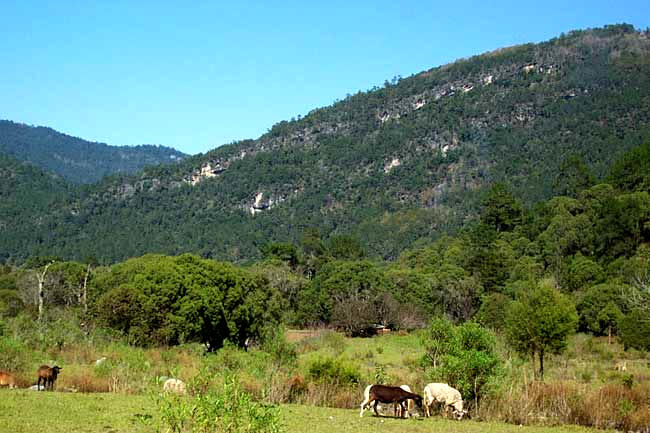Excerpts from Jim Conrad's
Naturalist Newsletter
from the December 18, 2006 Newsletter issued from Sierra Gorda Biosphere Reserve, QUERÉTARO, MÉXICO
A VIEW OF EASTERN SIERRA MADRE GEOLOGY

Above you can see a view from the bungalows at San Juan de los Durán. It reveals a bit about Mexican geology.
Behind the sheep you see a mountain slope, the ridge of which is defined by the slanted outcropping of a layer of white limestone rock. Limestone is sedimentary rock originally deposited as horizontal layers of limy marl, mostly on sea floors, so a lot of energy has been used raising the former seabed more than 4500 vertical feet to where we see it today. This isn't anything extraordinary, however. The Earth does such things all the time, and much, much more.
Those outcropping limestone rocks highlight a big difference between the Eastern and Western Sierra Madres. Our Eastern mountains are mostly composed of sedimentary limestone of predominantly Cretaceous Age (144 to 65 million years old), while the Western Sierra Madres are mostly of volcanic origin, consisting largely of old lava flows, erupted ash and such of a generally younger age. In between the two Sierra Madres, which merge in the south like the arms of a V, lies Mexico's Interior High Plateau or altiplano, which is tilted so that it is higher in the south than the north.
If you follow the Eastern Sierra Madres north they merge into western Texas's mountains where certain ranges are known by such names as the Davis Mountains and the Guadalupe Mountains, and then farther north they acquire the grand identity of the Rocky Mountains. Biologically the continuity of this series of mountains is significant because it means that plants and animals find no great ecological barrier keeping them from moving north and south.
One consequence of this vast upland being continuous is that in this part of Mexico there are relatively few endemic bird species. Remember that in the northern Yucatan we had several endemics because northern Yucatan was isolated from other arid-scrub ecosystems by the ocean on three sides, and a rainier climate to the south. The Yucatan was an ecological island, and islands produce endemics. The Eastern Sierra Madres just go on and on, one mountain range after another, letting genes from contiguous populations mingle with ease, thus keeping populations blending, and endemism low. Howell reports as the only bird-endemic for the entire Mexican Plateau, of which we are part, the Worthen's Sparrow, found north of Querétaro state.
Wikipedia provides a good Sierra Madre Oriental (Eastern Sierra Madres) page.